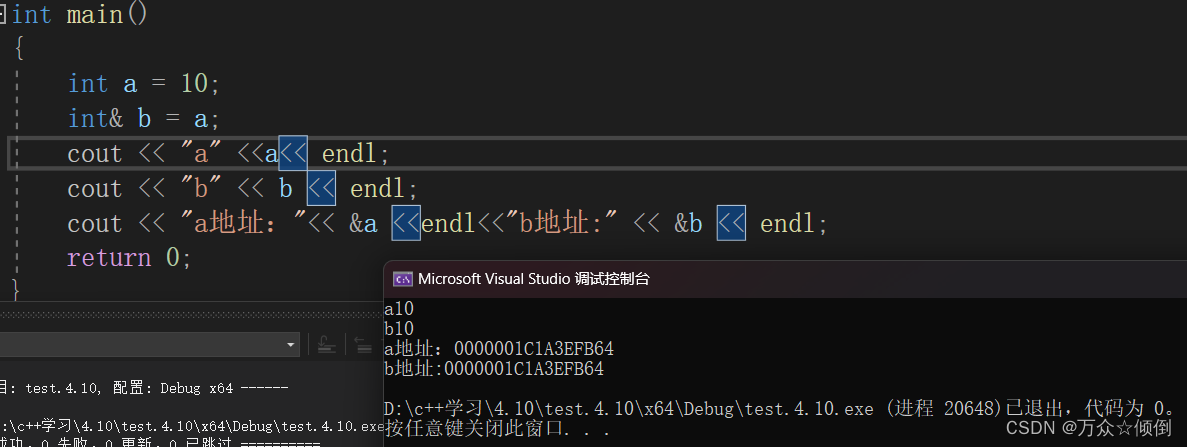您现在的位置是:首页 >学无止境 >c++学习之c++对c的扩展2网站首页学无止境
c++学习之c++对c的扩展2
目录
1.c/c++中的const
1 const概述
const 修饰的对象为一个常量,不能被改变
2 c/c++中const的区别
c语言中的const1 const修饰的局部变量,存在栈区,虽然不能通过const修饰的变量去修改栈区内容,但是可以 通过地址去修改
const修饰的全局变量是保存在常量区,不能通过变量名去修改.也不能通过地址去修改。
const修饰的全局变量,如果其他文件想使用,直接extern声明外部可用即可。
c中的:
在main.c中
#include <stdio.h>
const int b = 10;//const修饰的全局变量保存在常量区
void test03()
{
extern const int num;//声明num是外部可用的
printf("num=%d
",num);
}
//const修饰的全局变量
void test02()
{
//b = 100;
int *p = &b;
*p = 100;//错误的 不能修改常量区的内容
printf("b=%d
",b);
}
//const修饰的局部变量
void test01()
{
//在c语言中const修饰的变量保存在栈区
const int a = 10;
//a = 100;
int *p = &a;
*p = 100;
printf("a=%d
",a);
}
int main()
{
test03();
return 0;
}onst int num = 1;
c++中的const:
1 const修饰的局部变量赋值常量时,局部变量保存在符号表中,修改不了,是一个常量
2 const修饰的全局变量保存在常量区,不能被修改
3 const修饰的全局变量默认是内部链接属性,加上extern修饰变成外部链接属性
mian.cpp
#include <iostream>
using namespace std;
const int b = 1;
void test03()
{
extern const int num;
cout << num << endl;
}
void test02()
{
//const修饰的全局变量存在常量区
int *p = (int *)&b;
*p = 100;//错误的
cout << b<< endl;
}
//c++中const修饰的局部变量
void test01()
{
//c++中const修饰的局部变量存在符号表中
const int a = 10;
//a = 100;
//对const修饰的局部变量取地址 编译器会产生一个临时变量来保存a的地址
// int tmp = a; int *p = &tmp
int *p = (int *)&a;
cout << a << endl;
}
int main()
{
test03();
return 0;
}
extern const int num = 1;// const修饰的全局变量默认是内部链接属性.
c/c++中的const异同
相同的点:
c和c++中的const修饰的全局变量都是保存在常量区,不能被修改
不同的点:
c语言中const修饰的局部变量赋值为常量时,,局部变量保存在栈区,可以被指针修
改
c++中,const修饰的局部变量赋值为常量时,局部变量保存符号表中,不能被修改
c语言中const修饰的全局变量默认是外部链接属性
c++语言中const修饰的全局变量默认是内部链接属性
c++中const修饰的变量,分配内存情况
const修饰的全局变量在常量区分配了内存
对const修饰的局部变量赋值为常量时,对其取地址,会在栈区分配临时的内存空间
const修饰的局部变量赋值为变量时,局部变量保存在栈区
const修饰的局部变量时一个自定义变量,也是在栈区分配内存
只有一种情况,const'修饰的局部变量被赋值为常量时,这个局部变量保存在符号表中,
符号表后中的变量,编译器直接访问,不会为其开辟空间。
#include <iostream>
using namespace std;
const int a = 1;//const修饰的全局变量在常量区分配了内存
void test01()
{
const int a = 10;//const修饰的局部变量赋值为常量没有分配内存,存在符号化表中
int *p = (int *)&a;//对const修饰的局部变量赋值为常量的变量取地址 会分配一个临
时的空间 int tmp =a *p =&tmp
}
void test02()
{
int b = 2;
//const修饰的局部变量赋值变量时 局部变量存在栈区
const int a = b;
int *p = (int *)&a;
*p = 100;
cout << a << endl;
}
struct stu
{
int a;
int b;
};
void test03()
{
//const修饰的变量为自定义变量时,保存在栈区
const struct stu obj = {1,2};
struct stu *p = (struct stu *)&obj;
p‐>a = 3;
p‐>b = 4;
cout << obj.a << " " << obj.b << endl;
}
int main()
{
test03();
return 0;
}尽量以const替换define
#include <iostream>
using namespace std;
namespace A
{
const int max = 1024;
const short max1 = 1024;
#define MAX 1024
}
// 宏没有作用域 宏没有类型(int)
void fun(int a)
{
}
void fun(short a)
{
}
void test01()
{
cout << A::max << endl;
cout << MAX << endl;
fun(MAX);//void fun(int a)
fun(A::max);//void fun(int a)
fun(A::max1);//void fun(short a)
}
int main()
30 {
31
32 return 0;
33 }宏定义的变量是做替换的,并且是全局的没有作用限制,但是const修饰的变量为常量是有范围的,范围即为原来变量的范围。
2.引用
引用的作用为给变量取别名。

在这里取别名后,两者的地址是一样的,且对a操作,b也会跟着操作。

#include <iostream>
using namespace std;
void test01()
{
int a = 10;
//引用一旦初始化之后不能改变引用的标识
int &b = a;
b = 100;
cout << a << endl;
int c = 1;
//b = c; 代表把c的值赋值给b 不是给c取别名为b
//int &d; 引用定义时必须初始化
}
void test02()
{
int a[5] = { 1,2,3,4,5 };
//int(&arr)[5] = a;
typedef int ARR[5];
//type & 别名 = 旧名
ARR & arr = a;
for (int i = 0; i < 5; i++)
{
cout << arr[i] << " ";
}
cout << endl;
}
int main()
{
test02();
return 0;
}函数的引用:
//指针方式交换
void swap(int *x, int *y)
{
int tmp = *x;
*x = *y;
*y = tmp;
}
void test01()
{
int a = 10;
int b = 20;
swap(&a,&b);
cout << a << " " << b << endl;
}
//引用交换
void swap_ref(int &x, int &y)// int &x =a, int &y =b)
{
int tmp = x;
x = y;
y = tmp;
}
int main()
{
int a = 10;
int b = 20;
swap_ref(a, b);
swap(&a,&b);
}引用的本质
#include <iostream>
using namespace std;
void test01()
{
int a = 10;
int &b = a;//编译器优化 int* const b = &a
//指针常量 不能改变指针变量的指向
// b =0x100;
b = 1000;// *b =1000
}
void fun(int *&q)//int *&q = p ==> 编译器 int * const q =&p
{
}
void test02()
{
int *p = NULL;
fun(p);
}
指针的引用
5 常量引用
#include <iostream>
using namespace std;
void test01()
{
int a = 10;
// const修饰的是引用& 不能通过引用去修改引用的这块空间的内容
const int &b = a;
//b = 1000;//err
}
void test02()
{
//int &b = 100;//不能引用常量
const int &b = 1;//int tmp =1 ,const int &b= tmp
}
int main()
{
return 0;
}内联函数
内联函数的基本概念
2 宏函数和内联函数的区别
//宏函数
#define MYCOMPARE(a,b) (a)<(b)?(a):(b)
//内联函数
inline int mycpmpare(int a, int b)
{
return a < b ? a : b;
}
void test02()
{
int a = 1;
int b = 5;
//int c = MYCOMPARE(++a, b);// ++a<b?++a:b
int c = mycpmpare(++a, b);
cout << c << endl;
}class Person{
public:
Person(){ cout << "构造函数!" << endl; }
void PrintPerson(){ cout << "输出Person!" << endl; }
}类里的成员函数默认为内联函数。






 U8W/U8W-Mini使用与常见问题解决
U8W/U8W-Mini使用与常见问题解决 QT多线程的5种用法,通过使用线程解决UI主界面的耗时操作代码,防止界面卡死。...
QT多线程的5种用法,通过使用线程解决UI主界面的耗时操作代码,防止界面卡死。... stm32使用HAL库配置串口中断收发数据(保姆级教程)
stm32使用HAL库配置串口中断收发数据(保姆级教程) 分享几个国内免费的ChatGPT镜像网址(亲测有效)
分享几个国内免费的ChatGPT镜像网址(亲测有效) Allegro16.6差分等长设置及走线总结
Allegro16.6差分等长设置及走线总结